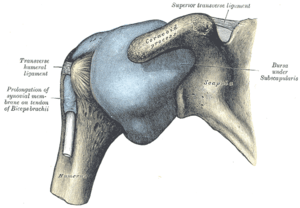Transverse humeral ligament
| Transverse humeral ligament | |
|---|---|
 Capsule of shoulder-joint (distended). Anterior aspect. (Transverse humeral ligament labeled at center left.) | |
| Details | |
| Latin | Ligamentum transversum humeri |
| From | greater tubercle |
| To | lesser tubercle |
| Identifiers | |
| Gray's | p.319 |
| Dorlands /Elsevier | l_09/12491258 |
| TA | A03.5.08.005 |
| FMA | 38406 |
| Anatomical terminology | |
The transverse humeral ligament is a broad band passing from the lesser tubercle to the greater tubercle of the humerus, and is always limited to that portion of the bone which lies above the epiphysial line.
It converts the intertubercular groove into a canal, and is the homologue of the strong process of bone which connects the summits of the two tubercles in the musk ox.
Eponym: Gordon Brodie's ligament.[1]
References
This article incorporates text in the public domain from the 20th edition of Gray's Anatomy (1918)
- ↑ "Definition: transverse humeral ligament from Online Medical Dictionary". Retrieved 2008-01-13.
| ||||||||||||||||||||||||||||||||||||||||||||||||||||||||||||||||||||||||||||||||||||